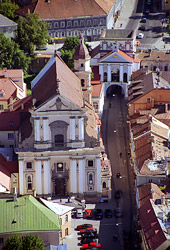St Teresa’s Church
Built by the Discalced Carmelites between 1633 and 1654, the Church of St Theresa of Avila is today closely linked with the chapel of the Gates of Dawn. It rose up alongside the Carmelites’ large and spacious monastery with several interior courtyards, and has never been closed. When the monastery itself was closed in 1844, the church together with the Dawn Gate chapel became a parish.
St Teresa’s Church was founded by Steponas Pacas, vice chancellor of the Grand Duchy of Lithuania, and designed by the Italian royal architects Constante Tencalla and Giovanni Battista Gisleni. Its architecture is inspired by the tower-less baroque churches built in Rome in the first half of the 17th century, modelled on Il Gesu, and is similar to that of the Carmelite Order’s other early churches in Lublin, Lvov, Krakow and elsewhere. The façade of the church is characterized by monumentalism, strict linear plasticity and extended architectural proportions with an air of nobility. It features luxurious and elegantly combined materials, including grey Swedish sandstone as well as black and white marble, for an extravagance that is rare in buildings of the Discalced Carmelites. On that count, the Church of St Teresa stands out in Vilnius for its grandeur and dignity. It blends the distinctive touch of a Roman architect and the royal feel of black marble into a standard Carmelite edifice.
The current interior of the church dates to the second half of the 18th century. Just above the main altar hangs a painting by Simonas Čechavičius entitled “The piercing of St Teresa’s heart”. The painting is surrounded by statues of other Carmelite saints. Above it, the architectural elements converge in a startling way on an image of the Blessed Virgin Mary with the Child Jesus and St Casimir, painted by Kanutas Ruseckas. St Casimir’s presence is not surprising, given his status as patron of the Discalced Carmelites’ Lithuanian Province. There is a valuable painting of Our Lady of the Scapular, probably from the 18th century, at an altar on the left side of the church. The paintings on the walls of St Teresa’s Church are the only remaining example of the once sweeping artistic heritage of the Lithuanian province of the Discalced Carmelites. The frescos, completed in 1764, portray the life of foundress St Teresa in a way that reflects the spirituality of the order. The dome of the church contains the scene of St Teresa’s death and glorification.








